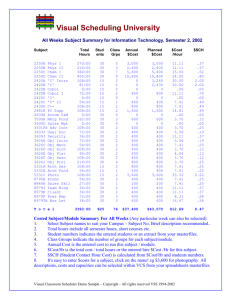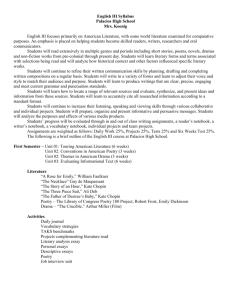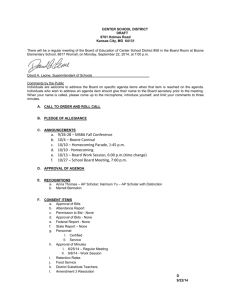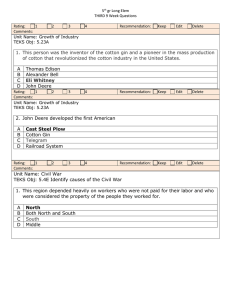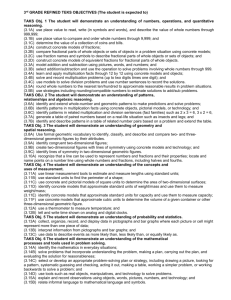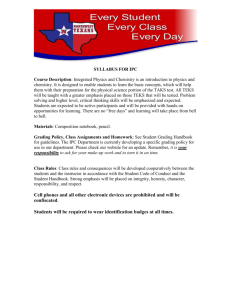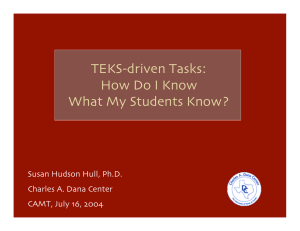Lesson Plan Format - Booker T. Washington Junior High School
advertisement
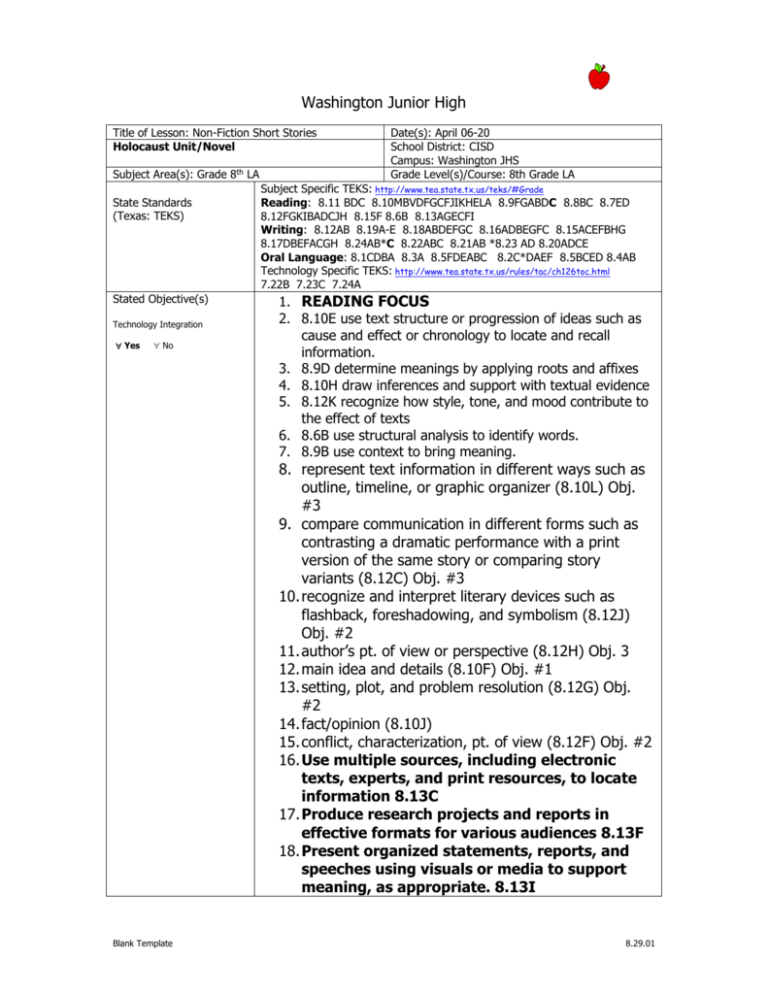
Washington Junior High Title of Lesson: Non-Fiction Short Stories Holocaust Unit/Novel Subject Area(s): Grade 8th LA State Standards (Texas: TEKS) Stated Objective(s) Technology Integration Yes No Date(s): April 06-20 School District: CISD Campus: Washington JHS Grade Level(s)/Course: 8th Grade LA Subject Specific TEKS: http://www.tea.state.tx.us/teks/#Grade Reading: 8.11 BDC 8.10MBVDFGCFJIKHELA 8.9FGABDC 8.8BC 8.7ED 8.12FGKIBADCJH 8.15F 8.6B 8.13AGECFI Writing: 8.12AB 8.19A-E 8.18ABDEFGC 8.16ADBEGFC 8.15ACEFBHG 8.17DBEFACGH 8.24AB*C 8.22ABC 8.21AB *8.23 AD 8.20ADCE Oral Language: 8.1CDBA 8.3A 8.5FDEABC 8.2C*DAEF 8.5BCED 8.4AB Technology Specific TEKS: http://www.tea.state.tx.us/rules/tac/ch126toc.html 7.22B 7.23C 7.24A 1. READING FOCUS 2. 8.10E use text structure or progression of ideas such as cause and effect or chronology to locate and recall information. 3. 8.9D determine meanings by applying roots and affixes 4. 8.10H draw inferences and support with textual evidence 5. 8.12K recognize how style, tone, and mood contribute to the effect of texts 6. 8.6B use structural analysis to identify words. 7. 8.9B use context to bring meaning. 8. represent text information in different ways such as outline, timeline, or graphic organizer (8.10L) Obj. #3 9. compare communication in different forms such as contrasting a dramatic performance with a print version of the same story or comparing story variants (8.12C) Obj. #3 10. recognize and interpret literary devices such as flashback, foreshadowing, and symbolism (8.12J) Obj. #2 11. author’s pt. of view or perspective (8.12H) Obj. 3 12. main idea and details (8.10F) Obj. #1 13. setting, plot, and problem resolution (8.12G) Obj. #2 14. fact/opinion (8.10J) 15. conflict, characterization, pt. of view (8.12F) Obj. #2 16. Use multiple sources, including electronic texts, experts, and print resources, to locate information 8.13C 17. Produce research projects and reports in effective formats for various audiences 8.13F 18. Present organized statements, reports, and speeches using visuals or media to support meaning, as appropriate. 8.13I Blank Template 8.29.01 ON-GOING READING FOCUS ALL YEAR: 8.6b,8.9bdf,8.10fg objective #1 12 TAKS (BASIC UNDERSTANDING) 8.12fgj Objective #2 10 TAKS (LITERARY ELEMENTS) 8.10eil,8.12ach Objective #3 10 TAKS (READING STRATEGIES) 8.10hj,8.11cd,8.12ik Objective #4 16 TAKS (CRITICAL THINKING SKILLS) Writing: 1. (8.15G) use literary devices effectively such as suspense, dialogue, and figurative language ORAL LANGUAGE: 1. (8.4B) Compare oral traditions across regions and cultures WORD WALL: Hostile, humorous, incredible, indifferent, joyful, light-hearted, patience, peaceful, and pleading LITERARY TERMS/FLASHCARDS: mood, tone, pt. of view, theme, conclude, summary, symbol, first person, describes, phrase, narrative, cause/effect, author’s purpose, main idea/details, non-fiction, setting, characterization, plot, conflict, climax, and resolution **Mood Words: surprising, resentful, dreary, suspicious, fear, mysterious **Symbolize Words: prosperity, conflict, freedom, uncertainty **Tone Words: unbiased, stern, celebratory, humorous, excited, suspicious, playful, and interested ACCOMODATIONS AND MODIFICATIONS: Cooperative groups and peer tutoring Focus on key words and concepts Access to support materials and notes Visual Aides and manipulatives Summarized notes Simplify wording Seat in close proximity to the teacher Blank Template 8.29.01 Repeat key information during the lesson Differentiated learning styles of learning Anticipatory Set (Focus) Make connections to previous experience and learning Technology Integration Yes No Explanation Technology Integration Yes No (What are you going to tell the students?) 1. 2. Explain the relevance of reading for understanding, communication, listening and analyzing different types of literature Connecting to prior stories for mental images Modeling 6+ Traits and Video Streaming Technology Integration Yes No Check for Understanding: Students take notes, open discussions both in small group and whole class, questions (CRISS two column notes and QAR’s) Guided Practice Group reading, monitor understanding, wk sheets, GUM book, Review Elements of Literature with questions for free writes and short paragraphs Technology Integration Yes No Opportunities to Relearn (Reteach) Check for Understanding: Students share reactions to reading through discussions and writing; dictionary utilization Review and re-teach utilizing differentiated learning, computer practice, video streaming, peer editing and revision Plato Program in the lab Technology Integration Yes No Independent Practice Technology Integration Yes No Assessment or Evaluation Story maps, research, supplemental material in TAKS format, presentations, group work, GUM book, spelling and vocabulary books, dictionary/thesaurus utilization Quiz, Test-oral and written, question-answer sessions, discussions, group work, student oral reading (making meaning) and supplemental material Technology Integration Yes No Enrichment Technology Integration Yes No Closure Technology Integration Yes No Materials Research and supplemental material, presentation and group work Open discussions, summary, presentations on learned material, restating objectives, test to assess Technology Resources: Plato lab, CD Rom, video streaming, computers, overhead and brainchild Other Resources: Library, other short stories, teachers trading classes ______________________ Teacher Blank Template _____________________ Subject _____________ Date 8.29.01

